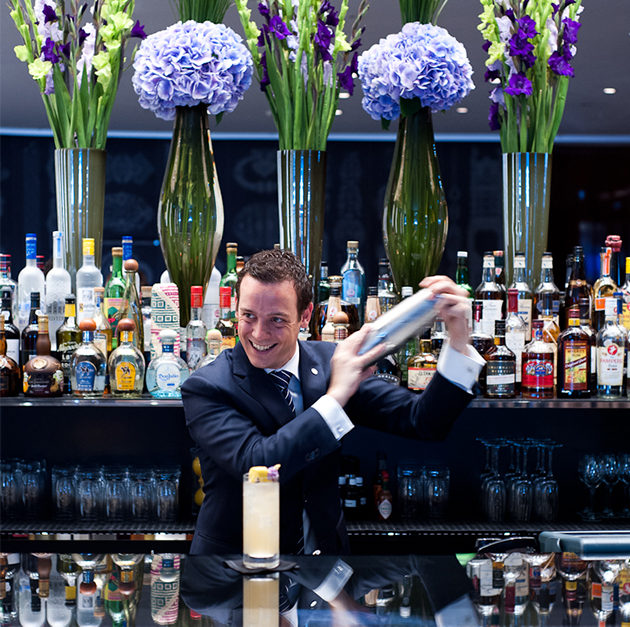
London’s bar scene loves a trend — one season it’s craft beers, the next it’s speakeasies. The latest fad, thanks to The London Edition, the gorgeous Marriott group hotel that opened in Fitzrovia in fall 2013, is punch. We recently sat down with Davide Segat, bar manager of the most intimate of the establishment’s four bars, Punch Room, so he could tell us why the fun, fruity libation is this year’s hippest beverage.
Why punch?
Punches are back in fashion. In any good cocktail bar you’ll always find a punch, but we thought, “If punch is working, why don’t we just focus on that?” Also it’s the size of the room that we have. We wanted to have a lot of people. We wanted to make people comfortable. We wanted people to share, so we put up a nice banquette, so all the tables can be united. You’ve got the punch bowl, you can start talking to different people; that’s what punch is all about.
How do punches differ from plain old cocktails?
Punch is the British answer to the Americans saying they created the cocktail. They did, in fact, create the cocktail, but the art of mixing spirits with juices, spices, water, citrus was done way before. The British went over to colonize India and mixed this spirit from the coconut tree, Arak, with lemon, sugar, tea and spices. That’s five ingredients and in India panch — spelled with an “a” instead of a “u” — means five. So that’s how it all started.
How are you giving this historic tipple a modern edge at Punch Room?
Punch today is so versatile. Among those five ingredients, there’s such a lot of choice. There are loads of citrus fruits: lime, lemon, orange, yuzu from Japan. Then tea. So many teas, so many different options. You can have a smoked one like lapsang souchong, for example, or a flower tea like jasmine and the flavor [in the punch] will change massively. And obviously, we add spices as well. At the Punch Room, we’ve kept the number five. We have 10 punches: five are new, modern, seasonal; and five are historic. The modern and seasonal ones change quite a lot, every month or two.
Do you have a favorite?
I have two. One is the Edition Punch, the house punch. It’s nice and easy and can be enjoyed by everyone. We wanted something British, so the main spirit is gin. One of the most famous cocktails in the world is a [Tom] Collins. Everyone loves a Collins because it’s a very simple-tasting cocktail. You’ve got a spirit, which is gin. You’ve got lemon. You’ve got sugar. And then you top up with soda, so it’s simple, refreshing and it suits a lot of palates. We changed it slightly to create the Edition Punch, using gin, lemon, oak moss syrup instead of regular syrup — which gives a freshness, a flowery flavor — and jasmine tea instead of soda. My other favorite is the Milk Punch, one of our historic punches. It’s a very long procedure. It takes a lot of passion, a lot of patience, but the result is nothing short of spectacular. The texture is incredible.
Where do you get the inspiration for your punches?
We’ve gathered a lot of old books, and not only books about drinks. There are a lot of punches in books that maybe narrate the story of an evening, and they will stop and talk about the punch. We fish them from different books, try them, adapt them to the modern palate. The spirits back then were not as good compared to the ones we’ve got now. There wasn’t the quality control. Now, they go through a lot of refinements. So, the whole recipe doesn’t necessarily work. You need to adapt it, but the idea behind it stays the same.
How have people responded to Punch Room?
A lot of people have been to house parties, tried punch, not liked it and so they deleted it as a [beverage] category. So, we keep a big bowl full of a daily changing punch on the bar. As soon as you sit down, we give you a little taste while you’re looking at the menu. Since we started doing that, the response from people has changed massively. They’re like, “Wow, I like this! Do you have anything like this?” [The bartender responds,] “You can also order it.” So, that’s one of our tools to get people into the punch.
How would you describe the London cocktail scene right now?
Massive — probably the best cocktail scene there is. The average bar in London is a top bar in most other cities in the world. It’s a good challenge for us, because when you open something, you can’t be complacent. You need to go around and see 20 places: What are the top bars doing? What can we do to match them? And what can we do that’s something new? What trend can we take and start doing that? So, it’s a lot of work but it’s a great challenge.
Photo Courtesy of Davide Segat

